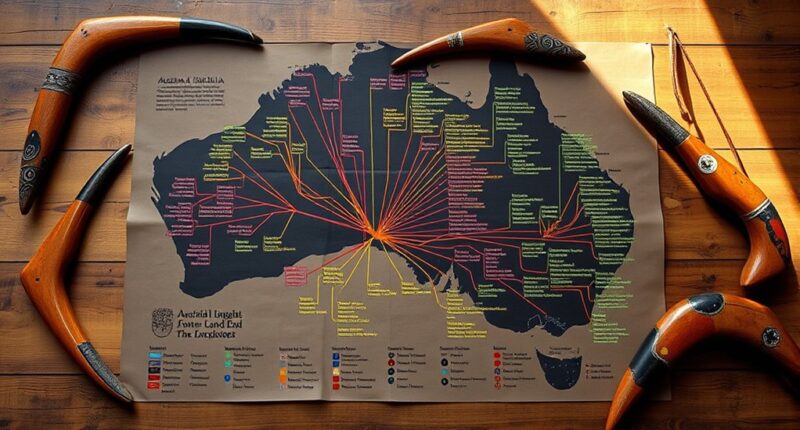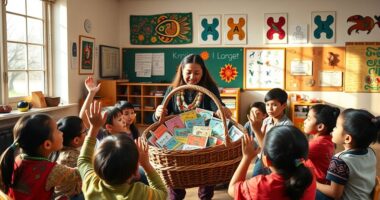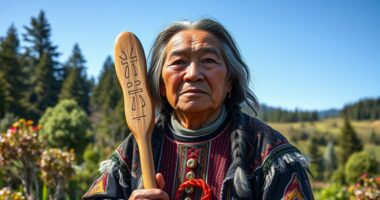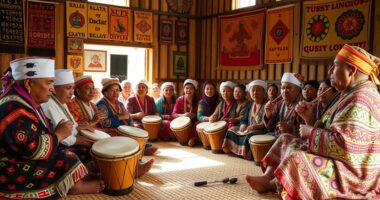Mapping the family tree of Australian Indigenous languages helps you understand their complex connections and origins. Most belong to the Pama–Nyungan family, covering around 90% of the continent, while smaller groups like Yolngu Matha and Tasmanian languages show diverse roots. By comparing features and tracing historical changes, you can see how languages evolved through migration and settlement. Continue exploring to discover more about these rich linguistic stories and their cultural significance.
Key Takeaways
- Indigenous Australian languages are primarily classified into the large Pama–Nyungan family and smaller distinct families.
- Family trees visually represent language relationships, shared features, and historical connections.
- Historical linguistics compares words and structures to trace language evolution and common ancestors.
- Language mapping reveals migration patterns, cultural exchanges, and regional divergence over thousands of years.
- Modern tools and technology enhance the precision of classifying and understanding the complex Australian language family tree.

Have you ever wondered how many Indigenous languages are spoken across Australia and where they are located? The answer is complex, as there are hundreds of distinct languages, each with its own unique roots and characteristics. To make sense of this diversity, linguists use the tools of language classification and historical linguistics. These methods help uncover how different languages are related, trace their origins, and map their distribution across the continent. When you look at the big picture, you’ll see that Australian Indigenous languages fall into several major groups, each with unique features and histories.
Language classification is the process of grouping languages based on shared features and origins. It helps you understand how languages evolve over time, branch out, and sometimes converge. In Australia, most Indigenous languages belong to the Pama–Nyungan family, which covers roughly 90% of the continent. This large family is characterized by specific phonological and grammatical traits that set it apart from other language groups. Outside of Pama–Nyungan, you find smaller, distinct families like the Yolngu Matha languages of Arnhem Land or the Tasmanian languages, which are now extinct but once formed their own unique branches. By classifying these languages, linguists can create a family tree that visually represents their relationships and shared features, acting like a genetic map of language history. Additionally, advances in linguistic technologies now allow for more precise analysis and comparison of these languages.
Language classification groups Indigenous Australian languages into families like Pama–Nyungan, revealing their shared features and histories.
Historical linguistics provides the tools to trace how these languages have changed over thousands of years. It involves comparing words, sounds, and grammatical structures across different languages to identify common ancestors and evolutionary patterns. When you understand the principles of historical linguistics, you can see how ancient languages diverged as groups of people migrated and settled in different regions. For example, similarities between languages in northern Australia reveal ancient connections, while differences in southern regions highlight long periods of separation and distinct development. This approach helps you appreciate not just where languages are spoken today, but how they came to be and how they are related through time.
Through the lens of language classification and historical linguistics, you start to see the rich tapestry of Australian Indigenous languages as a family tree rooted in deep history. Each branch reveals stories of migration, cultural exchange, and adaptation. Mapping these relationships isn’t just about organizing words; it’s about understanding the story of Australia’s first peoples—how they spread across the land, how their languages evolved, and how they continue to shape the continent’s cultural identity today.
Frequently Asked Questions
How Many Australian Indigenous Languages Are Currently Actively Spoken?
You’ll find around 150 Australian Indigenous languages are actively spoken today. Despite this linguistic diversity, many languages face endangerment, highlighting the importance of language revitalization efforts. By supporting communities in preserving their languages, you help maintain cultural identity and promote linguistic diversity. Your involvement can make a difference in ensuring these languages continue to thrive for future generations, fostering a richer, more inclusive cultural landscape across Australia.
What Efforts Are in Place to Preserve Endangered Languages?
Imagine a treasure worth protecting—that’s how you should see endangered languages. You can support language revitalization programs, which actively revive and teach these languages. Community involvement plays a vital role, encouraging elders to pass down knowledge and engaging youth in preservation efforts. By participating in these initiatives, you help guarantee that cultural stories and identities survive, turning endangered languages into vibrant symbols of resilience and pride.
Are There Any Written Records of These Indigenous Languages?
Yes, there are written records of Australian Indigenous languages, though most rely on oral documentation. Researchers and community members have created written materials, such as dictionaries, recordings, and texts, to preserve these languages. These efforts help in maintaining and revitalizing the languages, ensuring that future generations can access and learn them. While oral tradition remains essential, written records play a key role in language preservation.
How Do Linguistic Classifications Impact Cultural Identity?
Linguistic classifications greatly impact your cultural identity by highlighting the rich linguistic diversity among Indigenous groups. When you understand and preserve your language, you strengthen cultural traditions and foster a sense of belonging. Recognizing different language families promotes cultural preservation, ensuring that unique stories, knowledge, and practices are passed down. This deepens your connection to your heritage, empowering your community to maintain its identity amidst a diverse linguistic landscape.
What Role Do Oral Traditions Play in Language Transmission?
Oral traditions play a vital role in language transmission by using visual storytelling to pass down cultural knowledge. You actively participate in sharing stories, songs, and rituals that preserve your language and cultural identity. These traditions guarantee that future generations understand their history, values, and languages, fostering cultural preservation. Through oral storytelling, you keep your language vibrant and connected to your community’s heritage, maintaining a deep cultural continuity over time.
Conclusion
You’ve seen how diverse and interconnected Australian Indigenous languages are, with over 250 distinct languages spoken before colonization. Did you know that only about 120 of these languages are still actively spoken today? This highlights the importance of preserving and reviving these languages, as they hold invaluable cultural knowledge. By understanding their classification and relationships, you help keep this rich heritage alive for future generations.
Mary is a passionate writer who brings creativity and a fresh perspective to our team. Her words have the power to captivate and inspire, making her an essential contributor to our content. Mary’s commitment to storytelling and dedication to promoting Indigenous culture ensures that her work touches the hearts of our readers. We’re fortunate to have her as part of our team.










